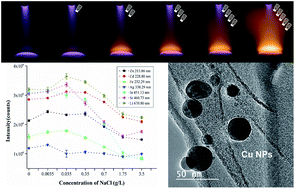Critical evaluation of SCGD-OES analytical performance in the presence of NaCl†
Abstract
The present study deals with the influence of sodium chloride (NaCl) on the analytical response and performance of solution-cathode glow discharge coupled to optical emission spectroscopy (SCGD-OES). In particular, the influence of different NaCl concentrations on relevant aspects such as signal stability, potential interfering emission from molecular species (e.g., OH or N2), sensitivity, and response to common additives employed for analyte response improvement, were investigated. The employed SCGD set-up was able to sustain the discharge under high salinity conditions (up to 3.50 g L−1 NaCl) and for long periods of time (>90 min). Nevertheless, it was observed that emission signal stability degraded at longer analysis times due to metallic electrode corrosion. Interestingly, the discharge reductive capacity at the plasma–liquid interface was highly promoted at the highest NaCl concentration (3.50 g L−1), proved by a notable increase in the production of a metallic residue in the cathode, which was composed of nanometric size particles. In terms of the analytical signal, the presence of NaCl clearly depressed potential interfering molecular emission. Analytical signals of several analytes (Zn, Cd, Fe, Ag, In, Sr and Li) were also studied for a broad NaCl concentration range. The results showed that atomic emission was slightly increased at the lowest NaCl concentration assayed (0.0035 g L−1), and depressed when surpassing 0.35 g L−1 NaCl concentration. Four elements (Fe, In, Sr and Li), were used to optimize the SCGD experimental conditions (inter-electrode distance and solution flow rate) and to evaluate the analytical performance at three NaCl concentrations (0, 0.35, and 3.50 g L−1). Moreover, the addition of formic acid and of Triton X-100 was also tested to improve the analytical features at different NaCl concentration levels. Formic acid promoted emission at a low NaCl concentration, while it depressed the emission of some elements at a higher NaCl concentration. Calibration curves for Fe, In, Sr and Li were obtained under optimized conditions at each NaCl concentration. Sensitivity was found to degrade on increasing the NaCl concentration, especially for Fe and In. However, LODs did not degrade as thoroughly.

- This article is part of the themed collection: Community Leaders: Ramon Barnes


 Please wait while we load your content...
Please wait while we load your content...